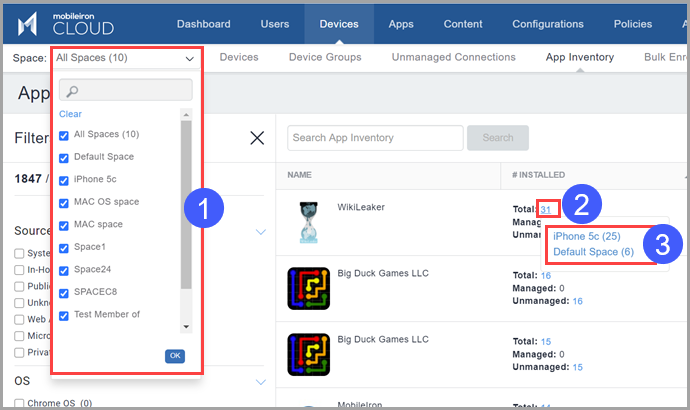App Inventory
This section contains the following topics:
- Filtering the display of apps
- Displaying the installed devices for an app
- Displaying the list of apps
- Displaying the installed Win32 apps on a device
- Creating Custom View Permission
- Exporting an App Inventory
The app inventory is the list of apps detected on enrolled devices. As an administrator you can use this page to get information on the apps being used by enrolled devices. You can answer questions like:
- Which apps are most popular?
- Do iOS devices get their apps directly from the App Store?
- How many Android users have downloaded an optional in-house app
 an app distributed by the device management service rather than downloaded from a public app store.?
an app distributed by the device management service rather than downloaded from a public app store.? - How many devices are using an outdated version of an app?
Filtering the display of apps
When you display the Devices > App Inventory page, all apps are listed. To narrow this list to certain apps, use the filters (left pane). For example, to narrow down the list to display only the private apps from Google Play, select Private under the Source section.
You can view app inventory across all or multiple space devices by selecting multiple spaces from the drop-down list. When you hover on the displayed apps, device counts are displayed. You can click on the count for an app to display all devices containing the app. Each app inventory record will be grouped by space.
You can search using either the app name or bundle/package ID.
If you  have selected multiple spaces, then
have selected multiple spaces, then  hovering the Total value in the # Installed column
hovering the Total value in the # Installed column  displays the install count per device space.
displays the install count per device space.

Displaying the installed devices for an app
Click the Managed, Unmanaged, or All number listed in the # Installed column.
Displaying the list of apps
Click the # Requested against the app in the app inventory to view the devices that requested the app. This is applicable only for MAM-Only devices.
Displaying the installed Win32 apps on a device
The app inventory displays Win32 apps on a device if the privacy configuration for that device allows for the collection of information for all apps on that device. You can configure the privacy policy for the device.
Procedure
- Determine which privacy configuration applies to the desired device by following the directions in Devices.
- Go to Configurations.
-
For the privacy configuration you noted in step 1:
- Select the configuration.
- Click Edit.
- Under Collect App Inventory, select For All Apps on the Device.
- Click Done.
Creating Custom View Permission
You can specify custom view permissions for users.
Procedure
- Go to Admin.
- Go to Roles Management.
- Click Add Custom Role.
- Select the Space-Specific Role option.
- Enter the user name in the Name field.
- From the Devices menu, click App Inventory.
- Select the View checkbox.
- From the Devices menu, click Device Actions.
- Click Save.
- Go to Users in the main menu.
- Click the new user that you created.
- Click Assign Roles.
- Select the app | Space-Specific checkbox, click Next.
- The Summary page displays the permissions that are assigned to the role you created.
- Click Done.
- Log in as the new user.
- Click Devices from the main menu.
- Click App Inventory.
- The App Inventory page now displays only the permitted applications for the user.
Exporting an App Inventory
As an administrator, you can request App Inventory reports using the Export to CSV option.
Procedure
- Go to Devices > App Inventory.
- Select an inventory from the list.
- Click Export to CSV.
The admin will be prompted with a pop-up informing that the export report would take some time to process. After submitting the request, the admin must wait for the request to be completed and to submit another request. Once the report is ready, the admin will be prompted with a message to either Download or Delete the report that has been generated. The admin will also receive an email containing a link to download the report.
If you cannot see the App Inventory page, it might be that you do not have the required permissions. You need one of the following roles:
- Device Management
- Device Read-Only